10+ Sample Building Contract
-
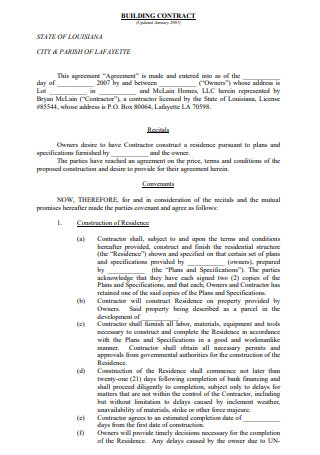
Building Contract Template
download now -
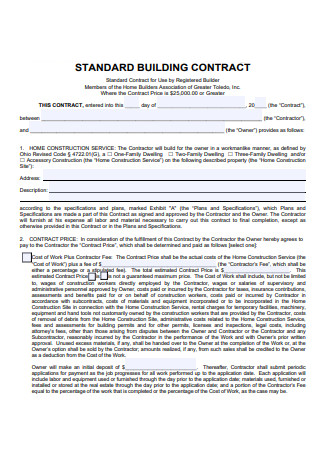
Standard Building Contract
download now -

Basic Building Contract
download now -
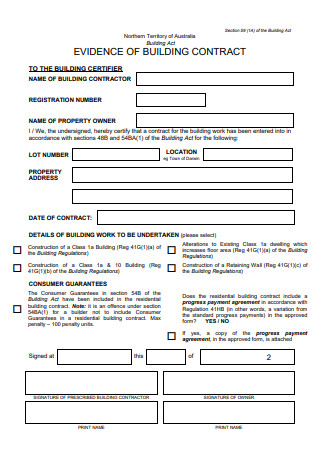
Evidence of Building Contract
download now -
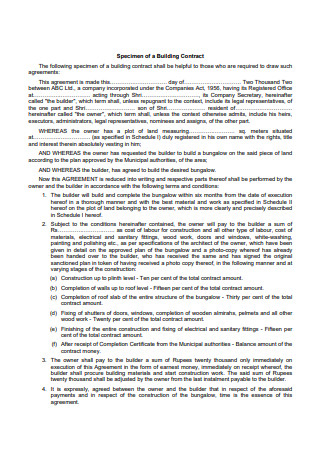
Building Contract in PDF
download now -
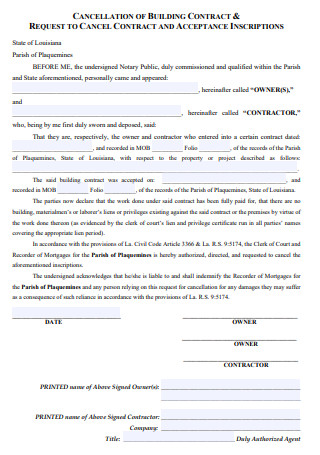
Cancellation of Building Contract
download now -
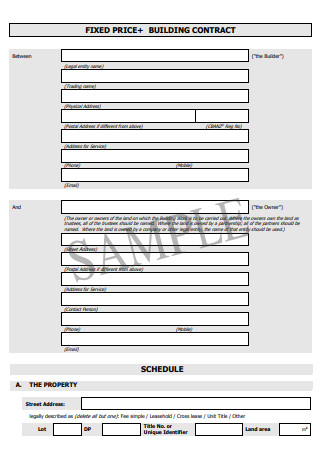
Sample Building Contract
download now -
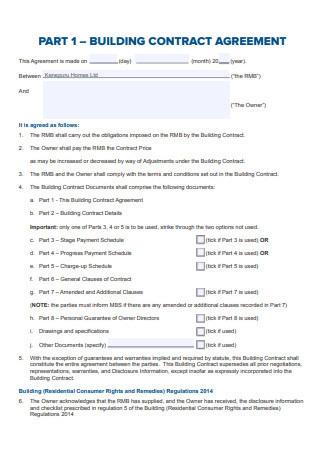
Building Contract Agreement
download now -
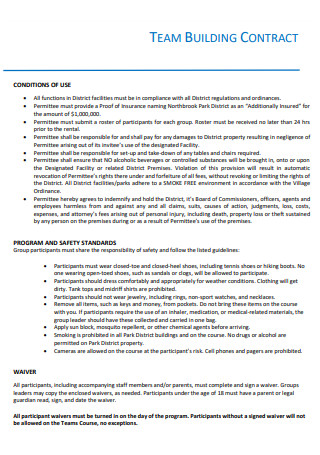
Team Building Contract
download now -
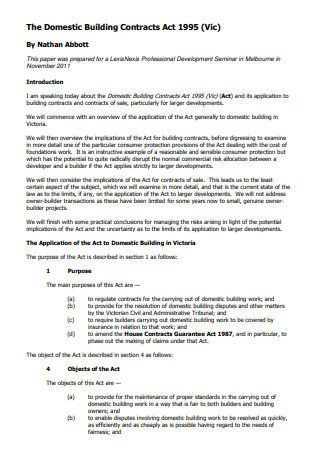
Domestic Building Contract
download now -
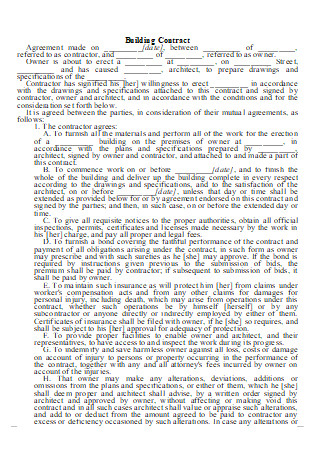
Building Contract in DOC
download now
FREE Building Contract s to Download
10+ Sample Building Contract
What Is a Building Contract?
How to Write a Building Contract?
What are the Types of Building Contracts?
FAQs
What are the elements of a building contract?
Is it possible to cancel a building contract?
How much does a building project cost?
What happens if a party breaches the building contract?
What Is a Building Contract?
Just like a supplier contract, a building contract is a type of contract that legally binds at least two parties onto a set of policies and conditions that both parties have agreed. This type of contract is created and signed before the building project takes place. Before the involved parties sign the contract, both parties usually send representatives to discuss the details that are included in the contract. Additionally, some contracts also involve more than three parties for many reasons. One of these reasons is a contractor is only specialized to perform certain tasks. In many cases, a client, which is also the employer, wants more than what a contractor can perform. In this case, another party has to be employed to achieve the goal of the employer.
For instance, a contractor is only specialized in creating a certain part of a house but the client wants a specific output. However, the client still wishes for the initial contractor to do its specialization. In this case, if both parties agree, another contractor or individual has to get involved in the contract to complete the desired results. In a building contract, the client usually has the most influence. One has the right to choose which type of contract they should utilise. After all, as a contractor, you intend to give what the client wants. Nonetheless, it doesn’t mean that you are going to agree on everything that the clients say. You still can reserve your right to disagree with the contract, especially if it goes against your company’s integrity and other important factors of doing business.
How to Write a Building Contract?
Indeed, with the current global health crisis (COVID-19 pandemic), the market for many industries is expected to decline. Nonetheless, according to the statistics and facts about the construction in the US posted in Statista, 2020 ended with around 1.36 trillion US dollars construction market size. Thus, creating a building contract is still worth learning for, which you are going to learn in this section.
Step 1: Write the Title and the Introduction
The first step of writing an effective building contract is to describe the purpose of the contract, which you should write as a title. The best introduction includes basic information, such as the date of the agreement will be signed, the name of the parties involved (individual or organizations), location of the project, work initiation, and, lastly, the expected end date.
Step 2: Declare the Work that Needs to be Done
In this step, state the specific jobs that your firm will perform. Don’t forget to incorporate the materials and tools that need to be used to complete the work. For instance, the project that you are about to work is for home improvement. In this case, you can write: paint the inner walls with a blue semi-gloss indoor latex paint. To do it, rollers and brushes have to be used. For the entire project, an estimated 3 gallons of white trim paint, 9 gallons of interior paint, and 6 gallons of exterior paint will be used.
Step 3: Write the Financial Information and the Payment Information
For the financial information, you will include details, such as the amount of the money that the client agreed to pay for doing the project. You may also write details, such as the non-refundable deposit, payment schedule, final payment, and interest. Take note, though, that the payment for the project depends on the type of building contract that you have agreed with the client. You will know more about the types of building contracts in the next section of the article.
Also, make sure that you have stated the payment installment dates. You can also include a penalty charge for late payments. This part is quite crucial. So, to avoid any misunderstanding, explain it clearly during your meeting. Write down the amount that you will charge and the date when the change occurs. Depending on the type of building contract in use, you will need to state how you handle the changes in the costs involved in executing certain tasks. Is it charged to you or the client?
Step 4: Describe the Project and Handling of Work Order Changes
In this step, you need to describe the project in the form of a brief description. Remember, though, you are writing a brief overview. Thus, don’t include every detail of the project. In the next section of your building contract, you will state the agreed terms for order changes. Just like the office cleaning proposal, including this section will protect you from the risks of additional costs and work.
Step 5: State the Methods to be Used for Resolving Disputes and Claims
A lot of things can happen within the duration of a project. There may be disputes and claims about the performance reports of your team and even the completion of the project. At times, estimates cannot be followed because of several affecting factors, which may lead to possible lawsuits to be filed in court. You will want to avoid that as much as possible. Nonetheless, problems can occur, so you have to prepare for them. Decide the certain course of actions to take will be used to resolve these issues. At this point, you may also specify which forum or jurisdiction to be used. Including this section in your contract may mean that you and the client are waiving your rights to file a claim. On the bright side, both of you can resolve the issue without delays, public interference, and, most importantly, expensive legal fees.
Step 6: End the Contract with Coverage Information and a Signature Line
The contract is created to protect both you and the client. Thus, it should not be just about you. The client will feel assured if you will include a statement addressing the coverage information. In this part, you will want to state that you will carry the employees’ compensation insurance. It would be helpful as well if you give the client the right to request a bond for the performance and payout, ensuring that the client is protected if you decide to default on your obligations.
Lastly, just like writing a car rental contract, reserve a space where you and the client can sign. This part will certify that all parties involved are agreeing to every detail included in the building contract. This part should include the printed name, address, and telephone number of both parties. You may also choose to declare the email address of both parties. Doing so allows you to send notifications about the project.
What are the Types of Building Contracts?
There are several types of building contracts that you can utilize for your construction project. However, the following are the major types of contracts that many contractors use.
FAQs
What are the elements of a building contract?
- Details about the contractor – This information is one of the first things that you are going to include in a building contract. This element includes the contractor’s license number, phone number, business address, and email address.
- Details about the client – Aside from the information about the contractor, a building contract cannot be completed without the details about the client. In this part, you will include the name of the client, phone number, home address, email address, and the location of the property to be built.
- Description of the property in legal terms – To get this information, you will need to dig a little deeper. You can find it from the deed on record in the county clerk’s office.
- Right to stop the project and to withhold payment – This element is crucial if the client happens to fail to pay you. It will also include a provision that states how each party can terminate the contract. Take note as well that the client has the right to refuse to give a payment if the quality of the work is poor or a condition is disregarded.
- Costs – In this element, the detailed cost involved in completing the project will be included. It is also the part where the payment terms are declared. For instance, if the homeowner agrees to pay in multiple installments, or pay a down payment before the project begins, it will be declared in this element. For installments, you will also put the dates and amount to be paid.
- List of the attachment of the contract – This element contains all the important items that you attach to the contract, such as the blueprints and the job classification requirement.
- Failure of client to obtain financing – Not everyone is qualified for financing. This element will ensure that the client can terminate the contract accordingly if one fails to acquire financing.
- Description of the work & the completion date – In this element, a detailed description of what is being constructed will be mentioned. The completion date can be an exact date or an estimated one.
- Breach of contract remedies – At times, a party may happen to breach the contract. To ensure that it is handled properly, the conditions or situations where a party can file a lawsuit will be declared through this element. You can also check our article about a breach of contracts if you wish to know more about it.
Other elements that you can see in a building contract include requirements for proper licenses, permits, and insurance, unforeseen circumstances and acts of God, inspection & access, change orders, warranties, no liens by subcontractors, amount of damages and limitation of liability, disposal of all materials and condition upon completion, and signature & date by both parties.
Is it possible to cancel a building contract?
The Associated General Contractors of America released a survey and analysis, indicating that due to the coronavirus outbreak, more contractors report canceled projects than starts. The question is: is it possible to cancel a building contract? Simply put, a building can be canceled for certain causes. A few of these reasons include unapproved site plans and permits, lot-specific requirements to build, lack of sales for the builder, zoning approvals, and contract cancellation clauses. Nonetheless, it is imperative to remember that a client cannot just simply back out from a building contract. The building contract that both the clients and the contractor signed includes clauses that declaring the proper way of terminating a contract.
How much does a building project cost?
Needless to say, a building project is expensive. However, the costs that you will have to pay may vary to the design that you prefer to build. The location of where you want the property to get built also affects the price. On average, in terms of the cost to build a house, you will need around $100 to $155 per square foot for the land. In addition to the lot that you will need to purchase, you will need to pay around $155,310 to $416,250.
What happens if a party breaches the building contract?
In general, breach of contract means that a party failed to follow what’s agreed in the contract. When a breach occurs and inflicts damage, the one who breached the contract will be responsible for the damages. Just like a rent contract, in a building contract, the responsible party may have to pay a certain amount of money to the party who suffered a loss. However, the consequences of breaching the contract may vary from what both parties have agreed.
Indeed, a building project is a long and tedious task. Nonetheless, the reward that you can get as a construction business owner is also quite high. Thus, from the marketing plan to the end of the construction, it is worth it to undergo the long and tiring process. Creating a building contract is just one of the steps that you have to take to towards the end goal of the construction project. Make use of the building contract samples and other information that you have learned from this article to create a more improved building contract.
